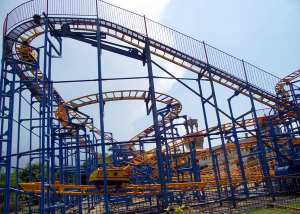The Coney Island amusement park in Havana once ranked among the most famous attractions in Latin America. Located close to the city centre, it covered a vast area from the La Concha beach to the FrutiCuba coffeehouse on 112th Street.
Right in front of the Coney Island, there used to be many restaurants offering all kind of meals, among them, for example, the Rumba Palace, La Cocinita, Mare Aperto and Himalaya, to name a few. Along the road there were many carts with fried food and there were also many cheap restaurants and bars in the neighbourhood, which contributed to the cosmopolitan atmosphere of the area. Among the visitors to the park there had also been several celebrities, who marvelled at the Crystal House, the five hundred-pound woman, or the great Roller Coaster. The amusement park had soon become an important place where people could find entertainment, have meetings or dates, etc.

Over the course of time, things had changed: the triumph of the Revolution brought a ban on private enterprise and the State wrought the park into a long state of paralysis. The surrounding neighbourhood sank into poverty and despite the fact that the Coney Island amusement park was still open and visited (out of inertia) by both locals and residents from other parts of the city, time and socialism contributed to its destruction. The devices and facilities gradually deteriorated and in the end, the park had to be closed. Over time it sunk into oblivion.
For over twenty years, the park that could once serve as an example of urban development of the 1950s looked like a large barren ground. In 2000, the Cuban government signed a contract with the Chinese to build an amusement park with twenty Chinese-style rides that would bear the name of “Isla del Coco”.
Not long ago I made a visit to the place and I could see that there were hardly any visitors – to be precise, there were three families. Only six children were there, riding over and over again on the same devices still operating – they were only five, mainly due to inefficiency and bad management of the park.
Despite the fact that it was after working hours, the employees operating the rides continued attending the customers. “Let’s see if we can earn some more money if we charge fees for rides without a ticket…”, says Elsa, who is in charge of the Chairoplane.
The boys on the Chairoplane did not want to quit and their parents wanted to please them, so they let them enjoy themselves. Meanwhile, Elsa explained that the park was funded by a Chinese donation and that older people who come there today say that the current number of visitors is barely a tenth of the number of those who used to come to the former Coney Island amusement park.
Javier, who is in charge of the ride called “The Dragon of Love”, says that the park employees have appealed to the National Assembly of People’s Power and to the Communist Party, calling for improvements. Yet, the state of the park is worsening day by day and no one has lifted a finger to do anything about the situation, or made at least some improvements.
Gisela, who attends to the Carousel, offers another ride to the six children on the device and tells us that sometimes she spends eight hours at work with only two children coming for a ride.
“The park belongs to the Recreatur company, whose director is in prison and the deputy director has gotten an injunction. The corruption has been massive here. Look at the number of broken devices: The Pirate Ship, the Octopus, the Flying Saucers, the Elephant, the Roller Coaster… Very few people come to the park, but, why would they? There are only about five amusement rides and there’s no access to any refreshments apart from some soft drinks. Javier can tell you more, he’s the secretary of the trade union.”
“It’s a pseudo trade union,” replies Javier. “Destruction and lies is all there is. The employees working with the public earn two hundred and fifty pesos, which is probably one of the lowest salaries in the country. Maintenance workers earn thousands. Ask me whether they have ever fixed anything… The Elephant has been out of service for two years due to a broken piece, which has already arrived, but we are waiting for the Chinese to come and put it in place. The Octopus has rotten legs and can’t be repaired anymore. The Roller Coaster has become a dinosaur on display. Most money in the park is made by the self-employed, who offer visitors at least something attractive.
This is how a Cuban amusement park looks like. “Amusement” is an attribute likely to be disputed by more than one visitor to the park.

Leave a comment